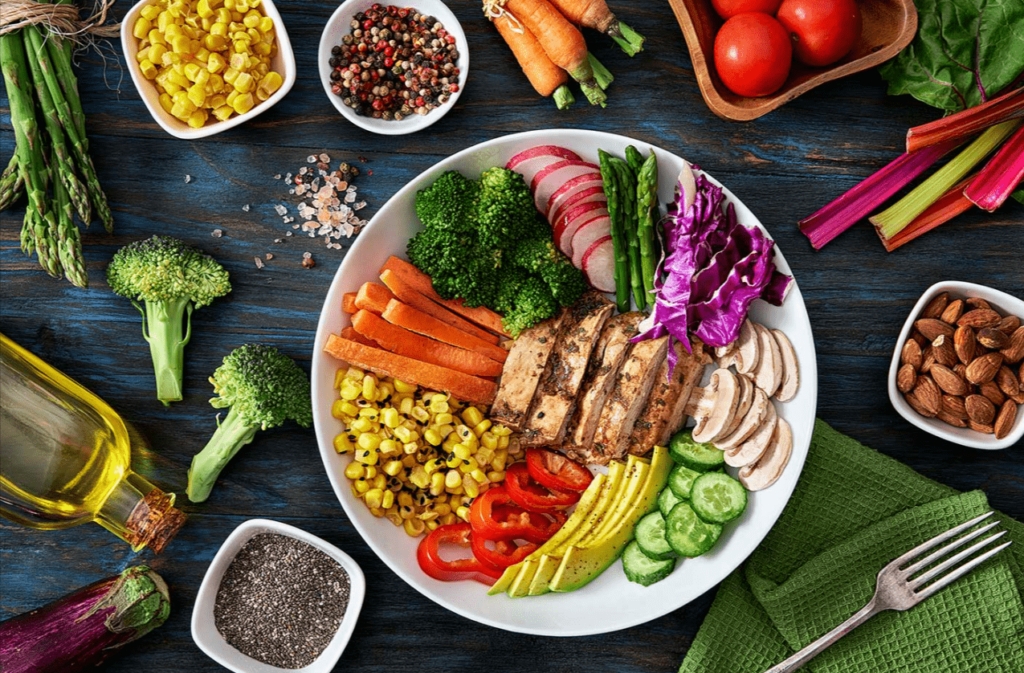Whole foods are natural, minimally processed items that do not contain artificial additives. They maintain their original nutritional content and include fresh fruits and vegetables, whole grains, and legumes.
To increase your intake of whole foods, it’s helpful to concentrate on additions rather than subtractions. By incorporating more whole and minimally processed foods into your diet, you’ll naturally replace less healthy, highly processed options.
Whole Foods vs. Unprocessed vs. Processed Foods
Whole Foods
Whole foods are those that remain as close to their natural form as possible, preserving their complete nutritional profile. They are free from artificial additives, including sugars, salts, and preservatives, which are often used to alter flavor or extend shelf life.
Examples of whole foods are fresh fruits, vegetables, nuts, seeds, legumes (like beans, peanuts, and lentils), and raw whole grains. A prime example would be an apple that is picked straight from the tree.
Ultra-Processed Foods
Ultra-processed foods have undergone extensive alterations from their natural state. These items are heavily processed through methods like canning or the incorporation of artificial ingredients. They often include high levels of added sugars, salts, unhealthy fats, and preservatives.
Typically, ultra-processed foods are found in pre-packaged forms. Common examples include potato chips, cookies, donuts, sugary cereals, and frozen ready-to-eat meals.
How to Incorporate More Whole Foods into Your Diet: Examples
Proteins
While the purest form of whole protein would involve hunting and preparing meat yourself or harvesting vegetables from your own garden, there are still many nutritious, minimally processed protein options available at your local grocery store. Some examples include:
- Dried beans, peas, and lentils
- Eggs
- Fish and seafood
- Poultry and beef
- Raw nuts and seeds
- Whole grains, such as quinoa
Carbohydrates
Carbohydrates often receive negative attention, but they are actually the main source of energy for your body. They are categorized into two types: complex and simple carbs. Complex carbohydrates digest more slowly, resulting in a gradual increase in blood sugar levels compared to simple (refined) carbs.
Healthy sources of complex carbohydrates include:
- Fruits such as apples, bananas, avocados, and berries
- Legumes like beans, peas, and lentils
- Vegetables including carrots, zucchini, and sweet potatoes
- Whole grains such as quinoa, barley, oats, millet, and brown rice
Fiber
The key distinction between complex and simple carbohydrates lies in their fiber content. Complex carbohydrates are rich in fiber, which aids in slower digestion and helps stabilize blood sugar levels. In contrast, simple carbohydrates are low in fiber and don’t keep you satisfied for long. For instance, consider the difference between consuming a sugary cereal and having scrambled tofu with vegetables and whole wheat bread for breakfast.
Fiber is exclusively found in plant-based foods. To meet your daily fiber intake, which is around 30 grams for overall health and disease prevention, incorporate a variety of fiber-rich foods into your diet:
- Fruits
- Legumes
- Nuts
- Seeds
- Vegetables
- Whole grains
Healthy Fats
While high consumption of saturated fats is linked to an increased risk of heart disease and type 2 diabetes, unsaturated fats play crucial roles in maintaining bodily functions. Saturated fats are predominantly found in animal products (except for coconut and palm oil) and are often used in ultra-processed foods to enhance their texture and flavor.
To incorporate healthy unsaturated fats into your diet, consider including the following:
- Avocados
- Fatty fish such as salmon, tuna, and mackerel
- Nuts like almonds, cashews, and walnuts
- Olives and olive oil
- Seeds like chia, flax, and hemp
Meal Planning
Boosting your diet with whole foods or enhancing overall nutrition can be effectively managed through meal planning. This strategy helps set specific boundaries that support your dietary preferences and is linked to a healthier eating pattern.
Schedule in Advance: Begin by evaluating your weekly schedule to figure out how many meals you’ll need to prepare.
Plan Your Meals: Create a list of the meals you intend to cook. Include both familiar dishes and new recipes you’d like to experiment with. You might also designate particular meals for specific days.
Make a Shopping List: Draft a grocery list by reviewing what’s already in your kitchen and identifying additional items you need. Aim to stick closely to this list during your shopping trip.
Prepare in Advance: To make your week easier, consider preparing some components of your meals ahead of time. This could involve chopping vegetables, cooking a large batch of grains, or preparing salads that can be consumed throughout the week.
Special Diets and Considerations
You can effectively incorporate whole and minimally processed foods into any specific dietary plan or while avoiding certain ingredients. This may require extra effort to ensure you bypass problematic items and find appropriate substitutes.
Begin by emphasizing fresh fruits, vegetables, whole grains, and lean proteins that fit your dietary requirements. For instance, if you have gluten intolerance, opt for naturally gluten-free grains such as quinoa, brown rice, and gluten-free oats.
For managing diabetes, concentrate on consuming high-fiber vegetables and legumes to help maintain stable blood sugar levels. Always check labels on packaged foods to avoid hidden additives or allergens that could interfere with your health.
Takeaway
There is considerable societal pressure to completely eliminate processed foods, but the reality is that most foods undergo some level of processing, meaning they’re not in their natural state. Opt for whole and minimally processed foods as much as possible to promote better health.
Aim to consume a variety of fruits, vegetables, nuts, seeds, whole grains, legumes, and lean proteins while limiting your intake of sugary, high-fat, and sodium-rich ultra-processed foods. Striving for perfection isn’t necessary; instead, focus on understanding the extent of processing in foods to make choices that maximize nutritional benefits.


